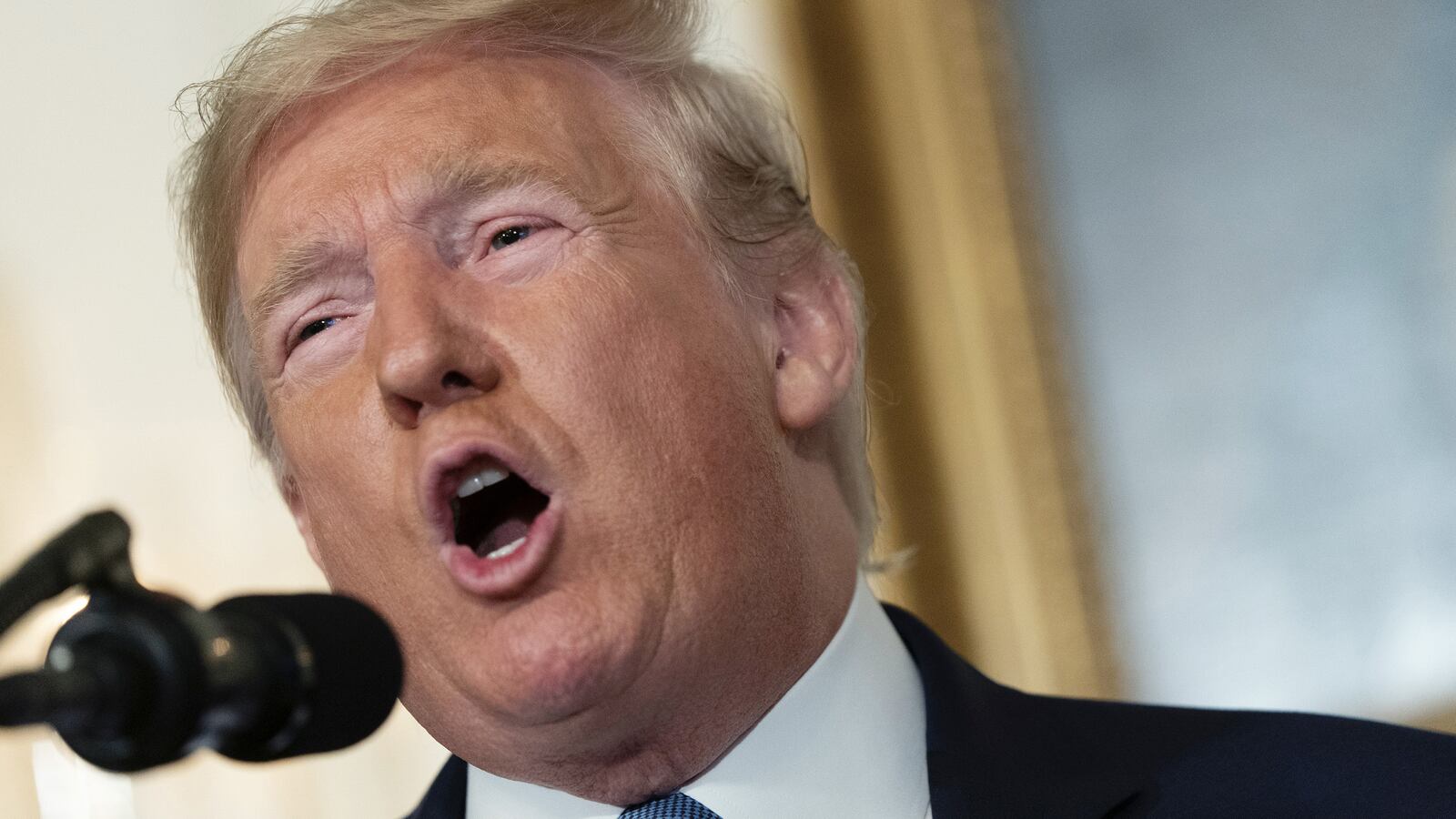In Dayton, in El Paso, in Parkland and in Pittsburgh, Donald Trump always reacts the same way. First, behind closed doors, with horror and compassion, followed almost immediately by grievance and scorn.
It’s the latter feelings that dictate the moments and days directly following, demolishing any chance for constructive dialogue or major reform.
For this president, it’s the same script every time, read haltingly from a teleprompter, just with differing numbers of dead.
According to interviews with nine people—former and current administration officials, campaign veterans, political operatives, conservative media figures, and friends of the president and Trump family—who have spoken to Trump in the wake of mass shootings, the president follows a predictable pattern:
In private, he’ll display a palpable anguish and outrage at the body count that, his aides concede, doesn’t typically come through in public. However, as he quickly consumes more and more media coverage of certain pundits, journalists, and liberals blaming him for the slaughters (particularly in cases of racist and white supremacist violence), his flashes of compassion are immediately supplanted by desires for going on the offense and reprisal. And there’s certainly never any room for even a semblance of self-reflection.
This routine is all but guaranteed this time around, given that 2020 Democratic contenders are already lining up to assign, at-minimum, partial responsibility to Trump, pointing out that the accused El Paso shooter’s online essay mirrors the president’s rhetoric on an “invasion” of the United States.
“I’ve seen him go from Point A to Point B in minutes,” said a former senior Trump administration official. “Usually what does it is something on TV like a [Democratic] politician or commentator saying he’s the one to blame that sets him off.”
The ex-official noted one example of this was how the president reacted to advisers and associates in the aftermath of the Tree of Life synagogue mass murder late last year. The alleged perpetrator had claimed that Jews were importing Central American migrant caravans and immigrant “invaders” into the United States. Trump and the Republican Party had made demagoguery about the caravans and the migrant “invasion” a cornerstone of their 2018 midterm elections strategy and messaging.
Neither privately nor in public did Trump admit any conceivable connection between his words and the motivations of the shooter.
“They’ll blame me for everything, it’s disgraceful,” the former official recalled the president saying in late October of last year, referring to figures in the media and the Democratic Party.
“President Trump is greatly moved when these tragic events happen. I have witnessed his reactions both in person and in phone conversations with him in the aftermath of mass shootings,” Eric Bolling, a BlazeTV host and a close friend of Trump’s, told The Daily Beast on Sunday. He added that the Parkland school massacre was one of those shootings. “He reacts with the same disgust and dismay as the rest of us do when we hear the reports come in. He has compassion and concern for the victims, families, and communities affected. But those emotions tend to get overshadowed as the comments from the left blaming him for the shootings roll in.”
This week, the president didn’t deviate from the formula. On Sunday, he kept mostly quiet and offline as he wrapped up his weekend at his golf club in Bedminster, New Jersey, telling reporters as he headed back to Washington, D.C., that “hate has no place in our country,” and that he’d have more to say the next day.
On Monday morning, Trump tweeted that “perhaps” the “strong background checks” should be tied to immigration legislation, an idea that would effectively kill any chance at a bill involving expanded background checks for gun purchases. He then posted to Twitter that “The Media has a big responsibility to life and safety in our Country,” blaming the “Fake News” for contributing “greatly to the anger and rage that has built up over many years. News coverage has got to start being fair, balanced and unbiased, or these terrible problems will only get worse!” (He said something similar shortly after the Tree of Life attack.)
He then retweeted a nearly year-old post from a fan account that reads, “Strong people stand up for themselves—but stronger people stand up for others. Thank you President @realDonaldTrump for standing up for America.”
For his speech at the White House later that Monday morning, Trump stuck to the teleprompter, and practically slept-walked through a series of talking points and ostensibly denounced “racist hate.” Trump was so robotic he called for prayers for the wrong Ohio city—Toledo instead of Dayton—without skipping a beat.
During the prepared remarks, he proposed some dangerous supposed fixes to the problem, including involuntarily locking up mentally ill people. And he made sure to criticize “dark recesses of the internet” and “gruesome video games,” as he and his White House team hamfistedly did after Parkland.
“Mental illness and hatred pulls the trigger, not the gun,” Trump said.
After he stepped away from the mic, White House aides waited for the president to inevitably exacerbate the situation, by Twitter and other means. To those who have worked for him over the years, this is standard operating procedure in Trumpworld. In fact, Trump ran this playbook starting the day after he announced his presidential run at Trump Tower.
In June 2015, shortly after news first broke of a white supremacist attack on a historic black church in Charleston, South Carolina, Trump gathered his top campaign officials to figure out what to do. Trump and his advisers agreed they needed to cancel an upcoming South Carolina event out of respect for the fallen and their loved ones. He had his staff draft official statements of condolence and condemnation. In these initial moments when it wasn’t clear who’d been murdered, the then-future president appeared consumed and visibly perturbed by the violence, repeatedly asking those around him, “Women, kids, in a church?” according to Sam Nunberg, a former political adviser to Trump.
It took roughly two days for Trump to go back to being Trump.
The day after the shooting, Democratic presidential candidate Hillary Clinton appeared to link Trump’s campaign-launch remarks about Mexican rapists to rhetoric that helps inspire racist violence. Trump was furious, and shot a video in which he responded, “Wow, it's pretty pathetic that Hillary Clinton just blamed me for the horrendous attack that took place in South Carolina,” adding, “this is why politicians are just no good. Our country's in trouble.”
Nunberg recounted that when he presented the Republican presidential candidate with a draft statement pushing back on Clinton’s comments, Trump quickly reviewed it, then ordered Nunberg to add a new line specifically calling out Clinton’s “email server,” for an extra dash of cattiness.
As he got farther and farther into his presidency, Trump only got worse. Following the Parkland massacre, the president called one of the survivors Samantha Fuentes, who had been shot in both her legs, while she was still in the hospital.
“He said he heard that I was a big fan of his, and then he said, ‘I’m a big fan of yours too.’ I’m pretty sure he made that up,” she told The New York Times early last year. “Talking to the president, I’ve never been so unimpressed by a person in my life. He didn’t make me feel better in the slightest.”
Fuentes added that Trump called the perpetrator a “sick puppy,” and that the president said, “‘Oh boy, oh boy, oh boy,’ like, seven times” during their phone call.






